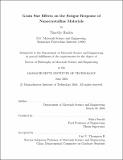Grain size effects on the fatigue response of nanocrystalline materials
Author(s)
Hanlon, Timothy, 1977-
DownloadFull printable version (10.82Mb)
Other Contributors
Massachusetts Institute of Technology. Dept. of Materials Science and Engineering.
Advisor
Subra Suresh.
Terms of use
Metadata
Show full item recordAbstract
The resistance of metals and alloys to fatigue crack initiation and propagation is known to be influenced significantly by grain size. Based on a wealth of experimental results obtained from microcrystalline metals, where the grain size is typically greater than 1 um, it is widely recognized that an increase in grain size generally results in a reduction in the fatigue endurance limit. On the other hand, a coarser grain structure can lead to an increased fatigue threshold stress intensity factor range, as well as a decrease in the rate of fatigue crack propagation. The relevance of these trends to ultra-fine-crystalline metals (grain size between 100 nm and 1000 nm) and nanocrystalline metals (grain size less than 100 nm) is relatively unknown. Such lack of understanding is primarily a consequence of the paucity of experimental data on the fatigue response of metals with very fine grains. In this work, the fatigue behavior of electrodeposited, fully dense, nanocrystalline pure Ni, with average and total range of grain sizes well below 100 nm, was examined. The fatigue response of nanocrystalline Ni was also compared with that of ultra-fine-crystalline and microcrystalline Ni wherever appropriate. It was found that grain refinement to the nanocrystalline regime generally leads to an increase in resistance to failure under stress-controlled fatigue whereas a deleterious effect was seen on the resistance to fatigue crack growth. To explore the generality of the above trends, similar experiments were performed on additional ultra-fine-crystalline material systems, produced using alternate processing techniques such as cryomilling and equal channel angular pressing. (cont.) Contact fatigue behavior was also examined down to the nanocrystalline grain size regime. Friction and damage evolution was monitored as a function of the number of unidirectional sliding contact fatigue cycles introduced at the surface of several material systems. Critical experiments were performed to isolate the effects of grain size and material strength. Over the range of materials investigated, strength rather than grain size dominated the contact fatigue response, with substantial improvements in strength resulting in reduced damage accumulation, and a lower steady state friction coefficient. Conversely, grain size was found to govern the rate of crack growth under mechanical fatigue, with all other structural factors approximately held fixed. In addition, the cyclic deformation behavior of nanocrystalline materials was also investigated. Experiments designed to extract the strain response at a constant range of imposed cyclic stresses provided the first evidence of cyclic hardening in a nanocrystalline material. This behavior was observed over a broad range of loading conditions and fatigue frequencies.
Description
Thesis (Ph. D.)--Massachusetts Institute of Technology, Dept. of Materials Science and Engineering, 2004. Includes bibliographical references (p. 151-158). This electronic version was submitted by the student author. The certified thesis is available in the Institute Archives and Special Collections.
Date issued
2004Department
Massachusetts Institute of Technology. Department of Materials Science and EngineeringPublisher
Massachusetts Institute of Technology
Keywords
Materials Science and Engineering.